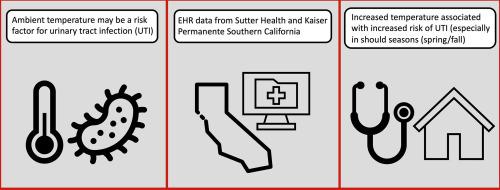Environment International ( IF 10.3 ) Pub Date : 2022-05-21 , DOI: 10.1016/j.envint.2022.107303 Holly Elser 1 , Sebastian T Rowland 2 , Sara Y Tartof 3 , Robbie M Parks 4 , Katia Bruxvoort 5 , Rachel Morello-Frosch 6 , Sarah C Robinson 7 , Alice R Pressman 8 , Rong X Wei 9 , Joan A Casey 10

|
Background
In the United States (US), urinary tract infections (UTI) lead to more than 10 million office visits each year. Temperature and season are potentially important risk factors for UTI, particularly in the context of climate change.
Methods
We examined the relationship between ambient temperature and outpatient UTI diagnoses among patients followed from 2015 to 2017 in two California healthcare systems: Kaiser Permanente Southern California (KPSC) and Sutter Health in Northern California. We identified UTI diagnoses in adult patients using diagnostic codes and laboratory records from electronic health records. We abstracted patient age, sex, season of diagnosis, and linked community-level Index of Concentration at the Extremes (ICE-I, a measure of wealth and poverty concentration) based on residential address. Daily county-level average ambient temperature was assembled from the Parameter-elevation Regressions on Independent Slopes Model (PRISM). We implemented distributed lag nonlinear models (DLNM) to assess the association between UTI and lagged daily temperatures. Main analyses were confined to women. In secondary analyses, we stratified by season, healthcare system, and community-level ICE-I.
Results
We observed 787,186 UTI cases (89% among women). We observed a threshold association between ambient temperature and UTI among women: an increase in daily temperature from the 5th percentile (6.0 ˚C) to the mean (16.2 ˚C) was associated with a 3.2% (95% CI: 2.4, 3.9%) increase in same-day UTI diagnosis rate, whereas an increase from the mean to 95th percentile was associated with no change in UTI risk (0.0%, 95% CI: −0.7, 0.6%). In secondary analyses, we observed the clearest monotonic increase in the rate of UTI diagnosis with higher temperatures in the fall. Associations did not differ meaningfully by healthcare system or community-level ICE-I. Results were robust to alternate model specifications.
Discussion
Increasing temperature was related to higher rate of outpatient UTI, particularly in the shoulder seasons (spring, autumn).
中文翻译:

加利福尼亚州的环境温度和尿路感染风险:使用电子健康记录的时间分层病例交叉研究
背景
在美国 (US),每年因尿路感染 (UTI) 导致超过 1000 万人次就诊。温度和季节是尿路感染的潜在重要风险因素,特别是在气候变化的背景下。
方法
我们研究了 2015 年至 2017 年加州两个医疗保健系统(南加州 Kaiser Permanente (KPSC) 和北加州 Sutter Health)患者中环境温度与门诊 UTI 诊断之间的关系。我们使用电子健康记录中的诊断代码和实验室记录来识别成年患者的尿路感染诊断。我们提取了患者的年龄、性别、诊断季节,并根据居住地址链接了社区级极端集中指数(ICE-I,衡量财富和贫困集中度的指标)。每日县级平均环境温度是根据独立坡度模型参数高程回归(PRISM)汇总的。我们实施了分布式滞后非线性模型 (DLNM) 来评估 UTI 与滞后每日温度之间的关联。主要分析仅限于女性。在二次分析中,我们按季节、医疗保健系统和社区层面的 ICE-I 进行分层。
结果
我们观察到 787,186 例尿路感染病例(89% 为女性)。我们观察到女性中环境温度与 UTI 之间存在阈值关联:每日温度从第 5 个百分位数 (6.0 ℃) 升高到平均值 (16.2 ℃) 与 3.2% 相关(95% CI:2.4、3.9% )当天 UTI 诊断率增加,而从平均值增加到第 95 个百分位数与 UTI 风险没有变化相关(0.0%,95% CI:-0.7,0.6%)。在二次分析中,我们观察到随着秋季气温升高,UTI 诊断率出现最明显的单调增加。医疗保健系统或社区层面的 ICE-I 之间的关联没有显着差异。结果对于替代模型规格来说是稳健的。
讨论
气温升高与门诊尿路感染率较高有关,特别是在肩季(春季、秋季)。











































 京公网安备 11010802027423号
京公网安备 11010802027423号